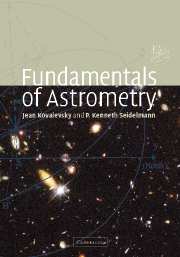Book contents
- Frontmatter
- Contents
- Preface
- List of abbreviations
- 1 Introduction
- 2 New observational techniques
- 3 Basic principles and coordinate systems
- 4 Treatment of astronomical data
- 5 Principles of relativity
- 6 Apparent displacements of celestial objects
- 7 Extragalactic reference frame
- 8 Dynamical reference frame
- 9 Terrestrial coordinate systems
- 10 Earth orientation
- 11 Stars
- 12 Double and multiple star systems
- 13 Astronomical phenomena
- 14 Applications to observations
- Appendix A Examples
- Appendix B Astronomical values
- Glossary
- References
- Index
9 - Terrestrial coordinate systems
Published online by Cambridge University Press: 05 November 2011
- Frontmatter
- Contents
- Preface
- List of abbreviations
- 1 Introduction
- 2 New observational techniques
- 3 Basic principles and coordinate systems
- 4 Treatment of astronomical data
- 5 Principles of relativity
- 6 Apparent displacements of celestial objects
- 7 Extragalactic reference frame
- 8 Dynamical reference frame
- 9 Terrestrial coordinate systems
- 10 Earth orientation
- 11 Stars
- 12 Double and multiple star systems
- 13 Astronomical phenomena
- 14 Applications to observations
- Appendix A Examples
- Appendix B Astronomical values
- Glossary
- References
- Index
Summary
In contrast with celestial reference frames, which have existed since the time when catalogs of stars over the whole sky became available, a global reference system for the positions on the Earth did not exist until direct geodesic links could be performed between regions separated by oceans and, more generally, by geographically or politically impassable barriers. So there were a number of local, geodetic coordinate systems, called datums, to which the positions of terrestrial sites were referred. They were given under the form of parameters defining the shape and the size of a reference ellipsoid, as well as its orientation with respect to some conventional features such as a mean pole and a zero meridian. The ellipsoid parameters were determined to best fit the local geoid (equipotential surface corresponding to the mean ocean level), and attached to the Earth by conventional coordinates of an initial point.
Introduction
At the beginning of the space age, positional and, later, laser or Doppler observations of satellites were used to link the individual datums and to place them in a unique terrestrial coordinate system. However, locally, countries continued (and many still do) to use their own datums for surveying and legal objectives. But for scientific purposes, this was a much too complex system, and a global terrestrial reference system had to be developed.
- Type
- Chapter
- Information
- Fundamentals of Astrometry , pp. 187 - 216Publisher: Cambridge University PressPrint publication year: 2004



